10 Best Ways to Promote Referral Links Free for Shopify Stores
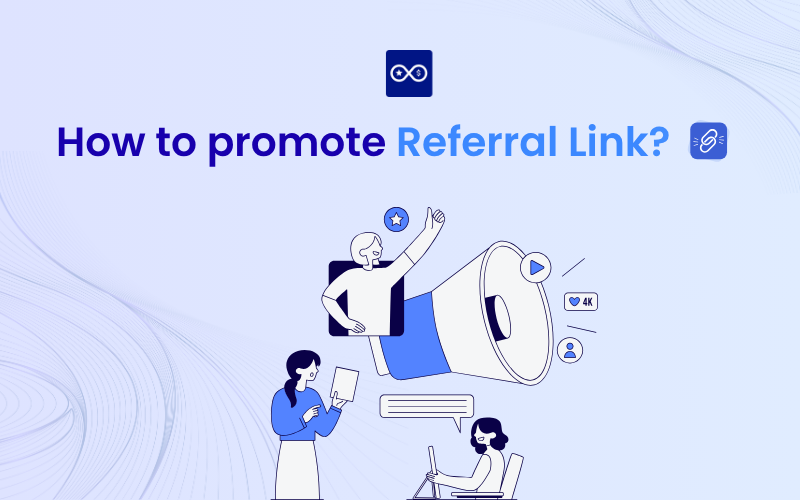
Every Shopify merchant knows word-of-mouth sells better than ads. But few know how to promote their referral link effectively, especially without spending a dime. As ad costs soar and organic reach drops, your referral link becomes a hidden growth engine, turning happy customers into brand advocates. This guide reveals how to promote referral links for free, using the channels you already own: your website, emails, and social media to drive real, trackable growth. Let’s dive in!
Understanding referral link promotion basics
A referral link (referral URL) is typically a unique URL provided by a company or referral program that tracks sign-ups or purchases back to you, earning rewards such as commissions, discounts, or credits. Free promotion means avoiding paid advertising, instead using owned assets, community engagement, and content distribution. Key principles include:
- Value-first approach: Always lead with helpful information rather than direct sales pitches to build credibility.
- Compliance and ethics: Disclose affiliations (e.g., “#ad” or “referral link”) to maintain transparency, as required by FTC guidelines in the US and similar rules elsewhere.
- Tracking success: Use built-in analytics from your referral program app or free tools like Google Analytics to measure clicks, conversions, and engagement.
- Audience targeting: Tailor your promotion to niches where your link is relevant, such as tech forums for software referrals or lifestyle blogs for product ones.
Research indicates that referral programs can boost acquisition by 10-30% when promoted effectively, but free methods may take weeks or months to gain traction compared to paid ones.

>> You may also like: How To Promote a Referral Program For Your Shopify Stores? (15+ Free & Paid Tactics That Work)
Before you promote: Make sure your referral program is ready
Before you start shouting your referral link from the rooftops, take a quick step back. A well-prepared program is what turns casual interest into actual shares and shares into sales. Here’s your pre-launch checklist to make sure your referral campaign is set up for success:
1. Offer a clear, irresistible incentive
Your reward should be simple enough to understand at a glance think “Give $10, Get $10” or “Refer a friend, earn 15% off.”
2. Keep your landing page clean and shareable
Your referral landing page is the heart of your campaign. Make sure it loads fast, looks great on mobile, and gets straight to the point: what customers get, how it works, and a clear “Share Now” button. Moreover, don’t forget to add one or two social share buttons because the fewer clicks it takes to share, the more referrals you’ll get.
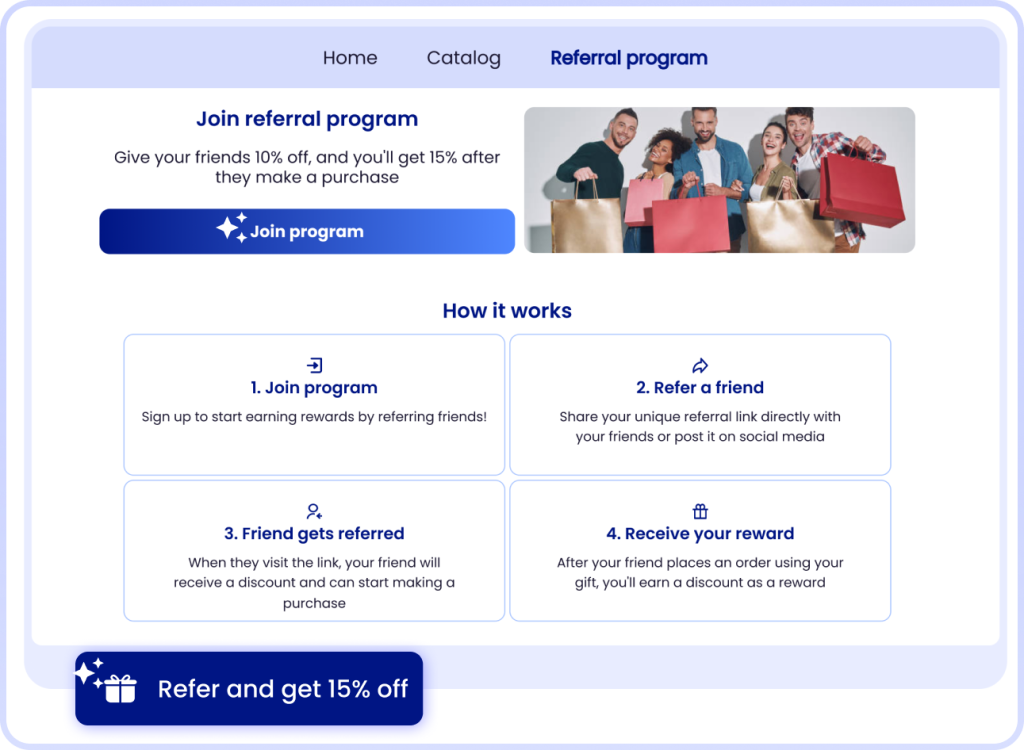
3. Double-check your link tracking
Nothing kills momentum faster than broken tracking. Ensure every referral link correctly attributes sign-ups and rewards both sides automatically. Use your app dashboard to test your referral flow from start to finish before going live.
4. Align visuals and messaging with your brand
Use consistent colors, tone, and imagery so customers instantly recognize it’s you. A seamless experience builds trust and makes your offer feel more professional and worth sharing.
How to promote referral link free for your Shopify stores?
Keyword Optimization on Your Shopify Website
Optimize site content with referral-related keywords to attract organic search traffic, leading visitors to your referral link embedded in pages or blogs. This drives passive referrals as searchers discover and share the program.
- Implementation: Research long-tail keywords like “earn rewards referring friends to Shopify fashion store” using free tools like Google Keyword Planner. Incorporate them into product descriptions, blog posts (e.g., “How to Save on Your Next Purchase with Our Referral Program”), and referral landing pages via Shopify’s editor. Add the link naturally in calls-to-action (CTAs) like “Share Now and Earn $20.”
- Benefits: Boosts SEO visibility, potentially increasing traffic by 20-50% without ads; low-effort once set up.
Title Tag and Meta Description Optimization
Craft compelling title tags and meta descriptions highlighting referral incentives to improve click-through rates from search results, funneling users to your link.
- Implementation: In Shopify’s theme settings or via apps like SEO Manager (free basic version), set titles under 50 characters (e.g., “Refer Friends & Earn Rewards | Your Shopify Store”) and metas under 150 (e.g., “Join our referral program for $20 off – share your link today!”). Link to a dedicated referral page.
- Benefits: Enhances SERP appeal, driving targeted traffic interested in rewards; can improve rankings over time.
- Example: Allbirds (sustainable footwear brand) used clever meta copy like “Friends don’t let friends wear shoes that hurt the planet” to promote its referral offer $15 off for both referrer and friend on purchases over $100. The message appealed to eco-conscious deal seekers and linked directly to a dedicated referral page, boosting visibility and supporting steady, organic customer growth, even though exact results weren’t publicly reported.
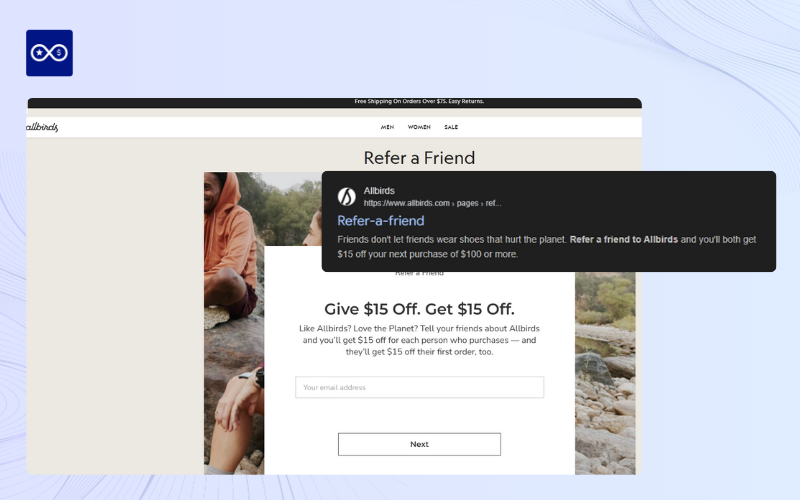
Influencer and Ambassador Outreach
Connect with niche influencers to promote your referral link in exchange for free products, leveraging their audiences for authentic endorsements.
- Implementation: Identify influencers via Instagram or Reddit searches; email them offering complimentary items from your Shopify inventory. Use free apps like Ambassador Affiliate Marketing for tracking (basic tier free). Provide personalized referral codes for sharing.
- Benefits: Accesses new audiences at no cash cost; one successful collaboration can generate dozens of referrals.
- Example: By partnering with influencers like Sjana Elise, Alo Yoga turned its referral program into a social movement. Posts featuring “Give 10%, Get $25” offers inspired followers to share organically, fueling a wave of community-driven growth that pushed Alo Yoga to the top of the activewear charts.
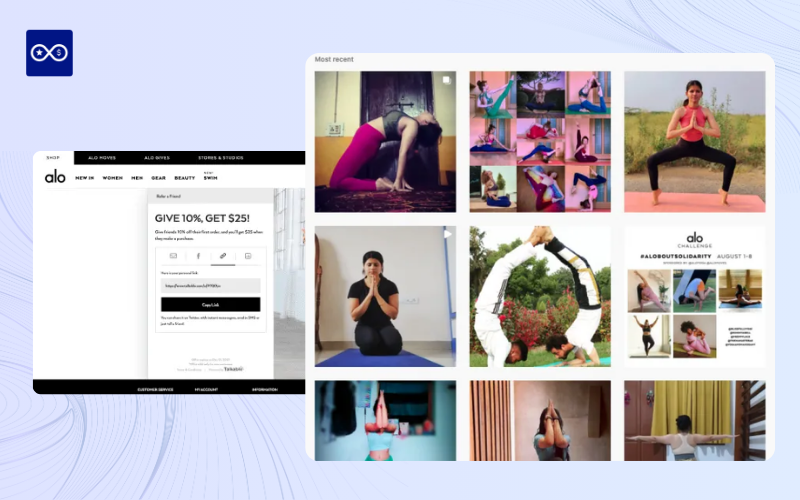
Listing in Comparison Shopping Engines (CSEs)
Submit your store and referral program details to free CSEs to expose the link to shoppers comparing options.
- Implementation: List on sites like PriceRunner or DealOz with product feeds from Shopify; include referral program blurbs and links in descriptions.
- Benefits: Reaches millions of users without fees; encourages comparisons that highlight your rewards.
- Example: Simba (mattress brand) strategically appeared on comparison shopping engines (CSEs) with referral mentions like “Refer for discounts”, attracting deal-savvy shoppers. This visibility, combined with creative campaigns, helped the brand tap into price-conscious traffic and steadily grow referral-driven sales.
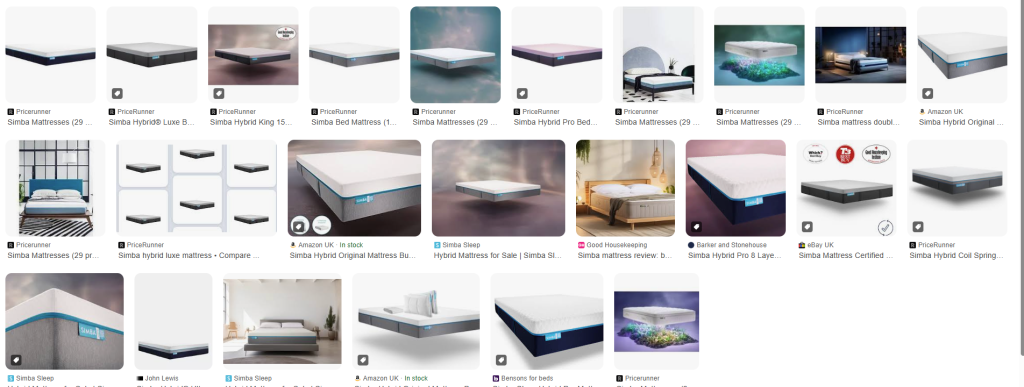
Engaging in Niche Forums and Communities
Participate in forums like Reddit’s r/shopify or niche subreddits to subtly share your referral link after building value.
- Implementation: Answer questions genuinely, then mention your program in signatures or relevant replies (e.g., “Check my referral program for similar stores”). Avoid spam to comply with rules.
- Benefits: Builds credibility; low-cost way to tap into engaged communities.
- Example: DockATot gained traction on Mumsnet, where parents actively discussed and shared their referral links. This organic buzz strengthened word-of-mouth and kept the brand’s “Give $10, Get $10” referral program effective for years.

Direct Customer Referral Requests
Politely ask satisfied customers to share your link post-purchase, capitalizing on positive experiences.
- Implementation: Add automated thank-you emails via Shopify’s flow or free templates; include the referral link and simple instructions.
- Benefits: High conversion from trusted recommendations; automated and free.
- Example: Casper uses post-purchase communications to encourage sharing referral links, offering gift cards, which supports customer acquisition without additional costs.
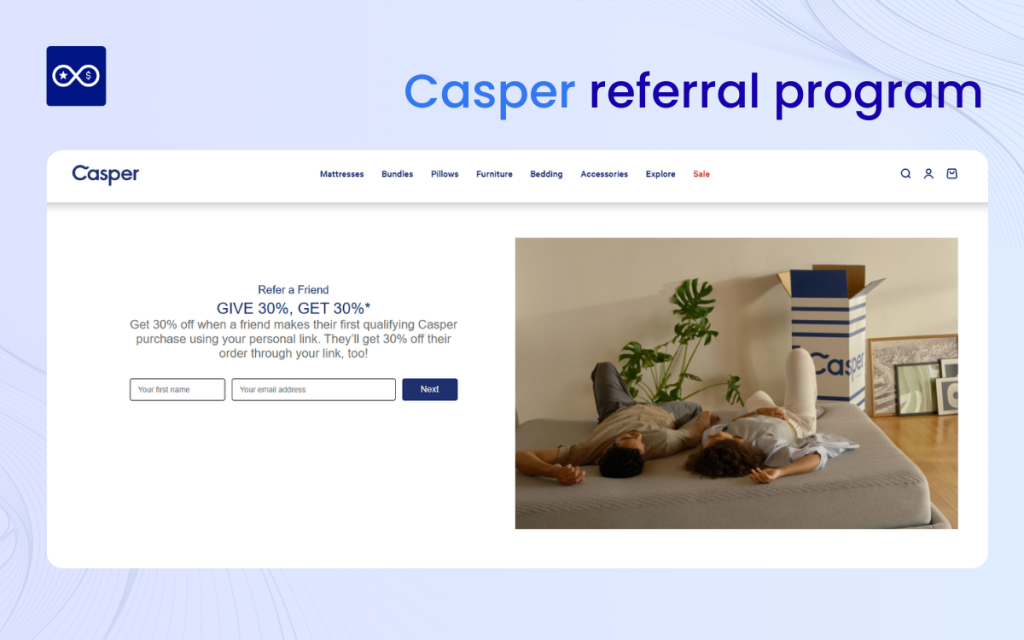
Social Media App Promotion
Use platforms like Instagram or X to create shareable content featuring your referral link.
- Implementation: Set up free store pages on Facebook/Instagram Shops integrated with Shopify; post visuals of rewards and include links in bios or stories.
- Benefits: Viral potential; reaches existing followers organically.
- Example: Alo Yoga uses #AloCommunity tags for user posts featuring referrals, building engagement. And the outcomes are enhanced visibility and referrals amid rapid growth.
Email Broadcasts and Newsletters
Announce your program to your customer list to spark initial shares.
- Implementation: Use Shopify’s email marketing (free for basics) or integrate with Mailchimp’s free tier; send personalized invites with the link.
- Benefits: Direct access to warm leads; high open rates for announcements.
- Example: SportPursuit adds referral CTAs in newsletters (plant a tree + £5 credit) that align with audience values, encouraging shares
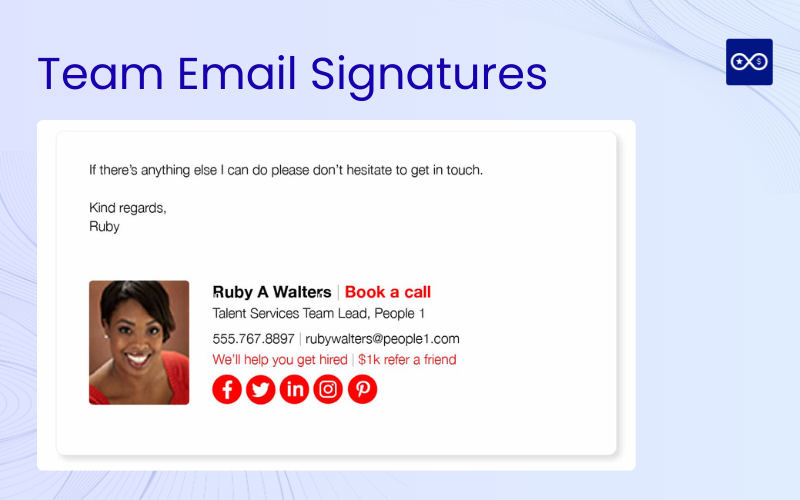
Content Creation and Blogging
Embed referral links in helpful blog content on your Shopify site.
- Implementation: Write a short post about how it works, how customers can earn rewards, and why you launched it. To optimize for SEO, potential customers searching for “referral discount [brand name]” or “brand name + referral link” will find your blog post first.
- Benefits: Establishes authority; attracts ongoing traffic.
Agency and Merchant Partnerships
Collaborate with other Shopify merchants or agencies for cross-promotions.
- Implementation: Reach out via LinkedIn or X for mutual shoutouts; share links without fees.
- Benefits: Expands networks; agencies prioritize value over small commissions.
- Example: Copper Cow Coffee collaborates with brands like GoNanas for co-promotions, cross-sharing referral links to expand reach.

Referral link promotion tactics comparison table
To aid selection, here’s a table comparing key tactics based on effort, reach, and suitability for Shopify niches:
| Tactic | Effort Level | Potential Reach | Best For Niches | Implementation Time | Key Benefit |
| Keyword Optimization | Medium | High (SEO-driven) | All (e.g., fashion, tech) | 1-2 weeks | Passive traffic growth |
| Influencer Outreach | High | Medium-High | Lifestyle, beauty | Ongoing | Authentic endorsements |
| Forum Engagement | Low-Medium | Medium | Tech, e-commerce communities | Immediate | Trust-building |
| Email Broadcasts | Low | High (existing list) | Retail, subscription | 1 day | Direct conversions |
| Social Media Promotion | Medium | High (viral) | Visual products (e.g., apparel) | Ongoing | Shareable content |
| Direct Requests | Low | Low-Medium | Any with repeat buyers | Immediate | Personal touch |
| Content Creation | High | Medium | Educational niches | 1-4 weeks | Long-term authority |
| CSE Listings | Low | High | Comparison shoppers | 1 week | Broad exposure |
| Title Tag Optimization | Low | Medium | Search-heavy stores | 1 day | Improved clicks |
| Partnerships | High | Medium | B2B or app-focused | Ongoing | Network expansion |
Common pitfalls to avoid when promoting your referral link
Before you start sharing your referral link everywhere, it’s worth pausing to make sure you’re not setting yourself up for wasted effort. Below are the most common pitfalls Shopify merchants face, along with what causes them, why they matter, and how to avoid them effectively.
Wrong or unappealing incentives
When rewards don’t resonate with your customers, even the best promotion strategy can flop. For example, offering irrelevant prizes or discounts that feel stingy can lead to poor participation – 70% of people skip referrals because the offer doesn’t excite them. Blue Apron’s “free meals” once drove sign-ups but caused high churn, proving unsustainable.
How to avoid: Research your audience before setting rewards. Tailor incentives to what your shoppers actually value, and balance generosity with profitability.
Unsustainable or overly generous rewards
Overly large rewards might look attractive but often attract opportunistic users who never return after claiming their prize. This can strain your margins and hurt lifetime value.
How to avoid: Keep rewards below acquisition costs and use tiered structures to encourage ongoing engagement.
Overcomplicating the referral process
If your program feels confusing or takes too many steps, people drop off fast. Barriers like fine print, manual confirmation, or limited sharing options (like email-only) drastically lower participation.
How to avoid: Simplify the process. Allow one-click sharing via multiple channels and automate reward distribution. Bloop’s plug-and-play setup is a great example of user-first design.
Keeping the program hidden
Even the best-designed program won’t work if people don’t know it exists. Many brands forget to mention their referral link in emails, banners, or post-purchase pages, leading to near-zero visibility.
How to avoid: Promote regularly across channels: newsletters, social posts, and in-store reminders. A gentle reminder every two months keeps it top of mind.
Neglecting mobile optimization
With most eCommerce traffic now happening on mobile, an unoptimized referral experience can cost you conversions. Non-responsive designs or missing mobile tracking hurt share rates.
How to avoid: Test your referral pages on multiple devices. Use native share buttons and cross-channel tracking to capture all touchpoints.
Lacking social proof and default messaging
A blank referral message or missing referrer name can make your program feel impersonal. Campaigns without proof or personalization often see up to 30% fewer clicks.
How to avoid: Pre-fill share messages with friendly, authentic copy and show the referrer’s name where possible. Vitality’s landing pages do this effectively, making invites feel personal and trustworthy.
Ignoring post-referral engagement
Many brands launch referral programs, then neglect them. Without follow-ups, customers lose motivation, and referred users often drop off before converting.
How to avoid: Send automated updates via email or SMS and use progress trackers to keep participants engaged.
Failing to prevent fraud
Referral fraud—like self-referrals or fake accounts—can quietly drain your budget.
How to avoid: Implement fraud detection measures such as device fingerprinting, IP blocking, or geo-restrictions.
Not targeting the right audience
Promoting to inactive or unsatisfied users rarely yields results. The wrong audience can even harm your brand image.
How to avoid: Use customer data to identify engaged, loyal buyers as your main referral base
No urgency or timeline
Open-ended referral programs often fade into the background. Without a reason to act now, people tend to delay participation indefinitely.
How to avoid: Create time-limited incentives like “Refer by July 4 for extra rewards.” Just ensure the deadline feels motivating, not rushed.
Inauthentic or low-quality content
Referral promotions that sound fake or pushy can erode trust—especially for affiliates or influencer partners.
How to avoid: Share genuine user stories, update your content regularly, and keep language transparent. Use readability tools like Hemingway to refine your copy and maintain an honest tone.
Ignoring seo and site speed
Slow referral pages and unoptimized content can cripple visibility and conversions. A delay of just 2 seconds can increase bounce rates by 50%.
How to avoid: Optimize your landing pages for both keywords and performance. Use tools like WP Rocket to improve load times and maintain SEO strength with evergreen referral content.
Poor funnel tracking and optimization
Without analytics or A/B testing, you’ll never know what’s working. Many brands lose conversions due to untracked links or checkout interruptions.
How to avoid: Set up end-to-end tracking, run A/B tests, and monitor metrics like ROAS or conversion rates. Tools like Voluum are useful for measuring impact accurately.
At the end of the day, promoting your referral link doesn’t have to cost a thing, it just takes creativity, consistency, and a little customer love. Every Shopify store has free channels waiting to be used: your post-purchase emails, your website, your social media, and most importantly, your happy customers. When you give shoppers a simple, rewarding reason to share, they’ll do the marketing for you authentically and at scale.
Start small, test what works, and watch your referral link become a steady source of new customers and loyal advocates!
Ready to put it into action?
Launch your referral program in minutes with Bloop Referrals & Affiliate Marketing – the easiest way to create, customize, and track referral links right inside your Shopify store.
